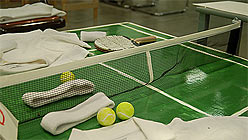As I stand between a mock campsite and a sail for humans, not boats, I watch a ping-pong ball hop lithely from a miniature tennis court and roll to a stop beneath a geometric wooden structure.
I’m back at Southern Exposure for an update on the non-profit’s current show, Working Conditions, where nine local artists are working for two months in a shared, public studio. When I wrote about the show‘s opening last month, the artists were still settling into the gallery. The room had that just-moved-in feeling of a new apartment — carefully arranged and zinging with potential. Now, a month later, the studios feel like they belong. And as plans become prototypes, the space has plumped with fresh work.
For a show based around the concept of labor, there’s a lot of playfulness here: artists and visitors carve their names into a picnic table, undulate on a waterbed, play Donkey Kong and compete in mini tennis. The environment’s lightness — a hallmark of socializing — underscores the fact that Working Conditions is, at its core, a social project.
The group of artists in this social space is not random. Each artist was chosen by a different member of the Southern Exposure curatorial committee, who worked to develop a roomful of people who would actively investigate the concept of labor, but work in totally different ways. It’s like a tiny, themed grad school program without professors, deadlines or official critiques. In the absence of school’s structure, the artists have been sharing informal feedback by reacting to and interacting with the artwork of their studio mates.

Nathaniel Parsons
Visitors, too, have had the uncommon opportunity to interact with the artists’ prototypes, essentially acting as test cases in creative trials. To develop ideas for a Wimbledon-themed animation project, Jennie Ottinger built a small-scale tennis court for visitors to use. When she colored ping-pong balls with highlighter marker to resemble tennis balls, she didn’t anticipate the highlighter turning the players’ hands green. Ottinger also observed that the tennis court table was too cramped for adult limbs. The next version of the miniature court will be slightly larger, and the tennis balls will be colored with pencil, which doesn’t rub off. While these changes would’ve also been made in a private studio, no one but Ottinger — and maybe one assistant — would’ve experienced green hands or the awkward table sizing.




